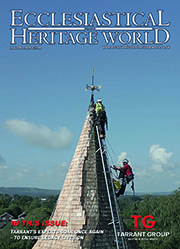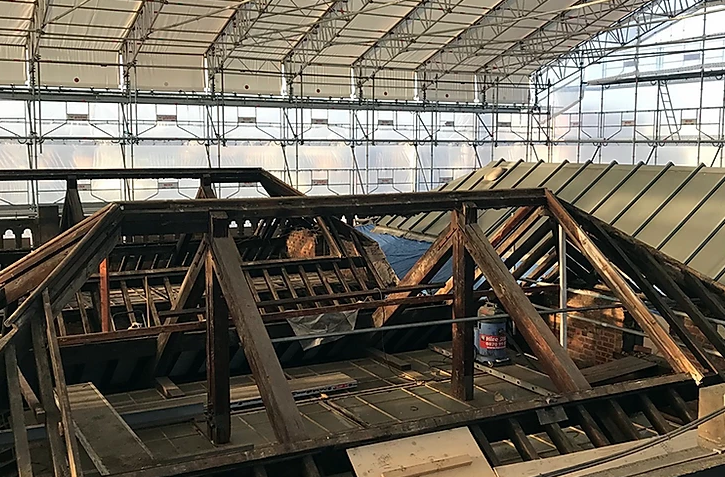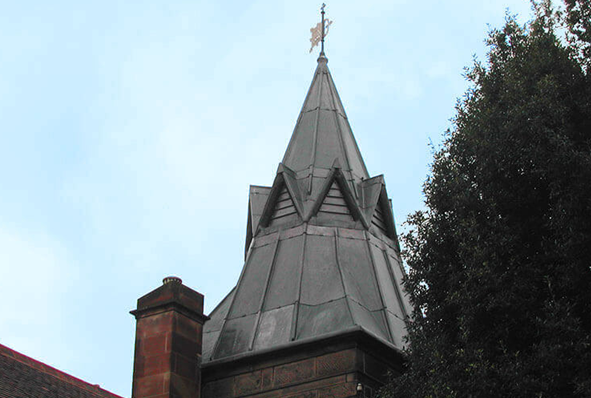Heritage Roofing
Heritage roofing - maintaining our iconic buildings
The UK is home to some of the most iconic buildings in the world, from stunning churches and cathedrals to historic stately homes. Each and every one of these remarkable feats of architecture requires regular maintenance to ensure they remain in the very best condition, allowing them to be enjoyed for generations.
Lightning Protection
When lightning strikes are you protected against this act of God?
The issue of lightning protection in churches is one that has exercised this publication for many years. In this four-part series of spotlights on the issue we will be revisiting various aspects of the subject, beginning with an overview of current thinking.
Traditional Lime
Lime: it’s better for buildings – and for the environment
It is now fairly well known that cement is not good for old buildings and that lime mortar should be used. But why? What are the advantages and what are the disadvantages? In order to begin to answer those questions it is necessary to understand the nature of traditional building, the process by which buildings used to be built, and how it differs from modern construction, the process by which we build today.
Audio Visual
Audio visual equipment in church buildings
This guidance is issued by the Church Buildings Council under section 55(1)(d) of the Dioceses, Mission and Pastoral Measure 2007. As it is statutory guidance, it must be considered with great care. The standards of good practice set out in the guidance should not be departed from unless the departure is justified by reasons that are spelled out clearly, logically and convincingly.
Read More...
CRE Events
Churches are coming under starter’s orders for CRE 25
Churches across the nation are beginning to make preparations for their visit to Christian Resources Exhibition’s CRE 25.
Insurance
You need to ensure that reasonable precautions are in place at your church to keep it safe for those who use it. To do this, you need to think about what might cause harm to people.
You will then need to decide if the precautions already in place are adequate. If they are not, you may need to identify further action to prevent any danger. When done formally, this is known as a risk assessment.
LPOW Grants
£23 million government package to support restoration of thousands of listed places of worship
Heritage Minister Sir Chris Bryant has announced that the Listed Places of Worship Grant Scheme will be extended into the next financial year, providing £23 million so that thousands of historical buildings, including churches, synagogues, mosques and temples, can carry out restoration work.
Lead Roofing
Lead is one of the oldest materials in the roofing industry and is still commonly used throughout the world today.
Lead roofing is a traditional roofing method which has been used in the industry for hundreds of years, and is therefore proven to be extremely reliable. Lead roofing, and sand-cast lead, in particular is ideal for old buildings such as churches or historical renovations, whereas milled lead roofing is a mass-produced alternative, used for precision and accuracy in homes and commercial buildings alike.
Home
ARBORICULTURAL SURVEYING
A. C. S. Consulting were instructed by Hanson Quarry Products Europe Ltd to undertake an arboricultural survey to inform on the future management of the parkland trees at Norton Conyers, Ripon, North Yorkshire. The survey is to be incorporated into a management plan prepared for the Grade II Registered Park and Garden.
Norton Conyers is a late medieval manor house with Stuart and Georgian additions. Owned by the Graham family since 1624 (except between 1862 and 1882). The exterior has distinctive Dutch-style gables, interior fine 18th plaster ceilings in the principal rooms. Visited by Charles 1 in 1633, James II and his wife in 1679 (the room and the bed they traditionally used are still on display), and Charlotte Brontë in 1839. The legend of a mad woman confined in the attics in the previous century is said to have given her the idea for the mad Mrs Rochester in 'Jane Eyre', and the house is an original of 'Thornfield Hall'; the discovery in 2004 of a blocked staircase connecting the first floor to the attics and clearly mentioned in the novel, aroused world-wide interest.
The site consists of the Grade II Registered Park and Garden of Norton Conyers House. The tree survey encompassed an area of parkland/pasture, an arable field and two small blocks of woodland located to the south and south west of the main house in the flood plain of the River Ure.
The parkland is currently used as grazing for sheep and cattle and benefits from a lack of public access. The woodland comprises two small blocks, the northern parcel is located on a sharp escarpment as a ribbon of woodland surrounding one of the estate’s dwellings. The southern parcel of woodland is rectangular with evidence of pheasant husbandry.
The survey identified approximately one hundred and forty trees of which a small number were identified as veteran trees and a number of others as verging on veteran status. Of particular note was a walnut which is considered an exotic in terms of veteran tree management. Trees were tagged and plotted on a plan for ease of identification.
Veteran trees are well documented and are an integral and valuable part of the lowland British landscape noted for their ability to support a diverse flora and fauna including many red data book species. The trees at Norton Conyers have historic interest as part of the landscape giving the surrounding landscape definition and maturity as well as enhancing the setting of the hall.
As part of the assessment, a Phase 1 Bat survey was undertaken. The object of the survey was to establish, where possible, whether any of the trees are used by bats and, if necessary, recommend further work in order to advise on mitigation measures. Overall, our assessment found the trees to have good bat potential. Many of the trees had suitable features, many of these specimens produce high volumes of insects as do the faeces from grazing animals. Veteran trees in general provide important habitats for bats throughout the year. With a number of veteran trees as well as blocks of woodland the opportunities for bats are high.

Our assessment concluded the trees at the site are clearly a principal component of the whole estate enhancing and giving scale and maturity as principle landscape features.
Typically, trees on such estates were planted for amenity, sports or as working trees. Working trees would typically be pollards/coppiced trees regularly worked or maidens allowed to mature then felled for their timber. We concluded that the trees surveyed were maidens with no clear evidence to counter this view. No lapsed pollards or coppice were noted.
On this basis, our recommendation was to do nothing for the next twenty to thirty years except to re-stock with new trees, preferably from nurseries of local provenance but ideally from the trees already growing in the parkland. Trees are adept at managing themselves without intervention. It is possible to artificially create veteran trees particularly in locations where there are few such trees. However, at Norton Conyers, in view of the number of potential veteran trees, it was felt an inappropriate management practice to artificially create them from younger trees which is possible where there are few trees deemed suitable.
It was recognised that not every tree within the parkland will be particularly suitable to go on to veteran status and that some selective felling will be required. Selective felling would not damage the overall appearance in the landscape, but would create space to allow the development of the new trees to grow to achieve their full dimensions. It was concluded that this will help to create a more age diverse range of trees. Age diversity is an important consideration in a group of trees that are all of a similar age. It allows the continuation of tree cover and landscape value allowing subtle changes to occur.
The area benefits from a lack of public access allowing the retention of trees that might otherwise be considered an unacceptable hazard. Trees with significant infestation of decay fungi, trees with structural defects and large volumes of dead wood that, in a more intensely used location may have to be removed or significantly pruned or excluded from public access, could be retained allowing nature to take its course.
ACS Consulting is an arboricultural consultancy based in Manchester and Glasgow providing advice on Trees and Development, Trees and Legal Aspects, Trees and Safety, Veteran Trees, Parkland/Wood-pastures, Hedgerows, Woodland Ecology Surveys, Trees and Bats and Native Planting.
Ian Murat MSc, F.Arbor.A, CEnv, MIEEM

Manchester – 01565 755422
Glasgow – 0141 354 1633




















